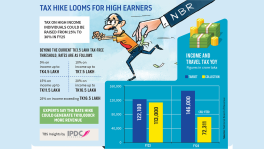The rise of BJP and fall of leftist and Congress in West Bengal
In 2011, Mamata-led TMC chipped away the hold of Left Front in West Bengal and has been in power since

For many decades the Indian state of West Bengal underwent bitter political violence. After Indira Gandhi had a state of emergency declared across India in 1975, the period was marked by large scale violence in West Bengal as the police force battled with the naxalites and ultimately crushed the movement in the state.
In the 1977 election of the state legislature, the Left Front, headed by CPI(M), won 243 seats thereby gaining a majority; and was in power for 34 years since.
In West Bengal, politics presently is dominated by the following major political parties: the All India Trinamool Congress (TMC), the Bharatiya Janata Party (BJP), the Communist Party of India (Marxist), and the Indian National Congress (INC).
Mamata Banerjee-led TMC rose phenomenally in West Bengal's politics through the Singur and Nandigram movements. TMC chipped away the hold of the CPI(M) led Left Front, and swept into the portals of power after nearly three and half decades years of uninterrupted Marxist rule in West Bengal.
From Congress to Trinamool Congress
Mamta Banerjee had accusing her then political party, INC, of not being serious about fighting the Left Front and CPI(M). This resulted in Mamata's expulsion from the Congress on 22 December, 1997.
Banerjee formed her own political party, TMC, which was registered with the Election Commission during mid-December, 1997. She formally launched TMC on 1 January, 1998 and swiftly became the primary opposition to the CPI(M)-led Left Front government in West Bengal.
In the 1998 Lok Sabha elections, the fledgling TMC, which had thrown in its lot with the BJP, won 7 seats and the Congress which fought alone just one among the 42 in the state. In the 1999 Lok Sabha elections, the TMC won 8 seats increasing its tally by one and its alliance partner BJP 2, INC 3 and Left Front 29.
TMC won the Kolkata Municipal Corporation elections in 2000 - with a non-left board taking charge for the first time in 20 years.
Mamata allied with the INC for the Assembly elections in West Bengal in the 2001 assembly elections. TMC contested 226 seats and won in just 60. In 2003 Panchayat Elections, Mamta Banerjee's party could win only 16 of the 713 zilla parishad seats. Many had written off Mamata when her party won just her own seat in the 2004 Lok Sabha elections.
In the municipal elections a year later, TMC lost control of the prestigious Kolkata Municipal Corporation and retained only eight of the 126 urban local bodies.
In the 2006 Assembly polls, TMC fought in alliance with BJP and cut a sorry figure winning only 29 out of 294 seats.
Nandigram, Singur and Mamata Banerjee becoming the Didi
When Nandigram violence incident took to the national scene, the TMC took the forefront in the movement against land acquisition for a chemical hub.
In November 2006 Mamata was stopped on her way to Singur in Hooghly district for a rally against the Tata Motors's Nano car project. This was the turning point in the long-drawn agitation at Singur with TMC chief demanding that 400 acre of the around 1000 acre acquired by the state government be returned to farmers who were unwilling to part with their land.
Mamata went on hunger-strike for 25 days on a makeshift dais at Esplanade in Kolkata in protest against land acquisition in Singur, but called it off on 28 December following an appeal from then Indian Prime Minister Manmohan Singh. The movement received support from a section of human rights groups, legal bodies, social activists like Medha Patkar, Booker prize-winning author Arundhati Roy and Magsaysay and Jnanpith Award-winning author Mahasweta Devi.
The move paid dividends for TMC, and in June of 2008, during the civic polls, the TMC and INC combine won eight civic bodies against the Left's five.
In 2009 the Trinamool and the Congress, along with the Socialist Unity Centre of India (SUCI), joined hands before the Lok Sabha polls and decimated the Left Front ruling West Bengal since 1977. The alliance bagged 26 of the state's 42 seats in the Lok Sabha with TC itself securing 19 seats followed by Congress 6 and SUCI. The Left Front won 15 seats, CPI(M) won 9.
TMC became the second largest partner in the United Progressive Alliance, while Mamata was inducted as railway minister. Six of her party colleagues were made ministers of state. In the July 2009 civic polls, the TMC and INC crushed the Left winning 13 of 16 municipalities. In the November 2009 Assembly bypolls, the Left managed to win just one seat, while Trinamool took seven and the Congress one.
TMC inflicted a crushing defeat on the ruling Left Front in civic polls seen as a trial run to this year's make-or-break assembly election, wresting the prestigious Kolkata Municipal Corporation and scores of urban municipalities.
Breaking the Left's grip on West Bengal
In 2011 Assembly Elections, INC and TMC reached a seat-sharing agreement with the former settling for 65 seats, against its original demand of 90, in the 294-member West Bengal Assembly.
In the 2011 West Bengal Legislative Assembly election, Left Front was defeated and TMC won an absolute majority of seats. Mamata's TMC won 184 seats, whereas the Left front 40 seats and the INC won 42 seats. Mamata Banerjee became the chief minister of West Bengal.
The success of TMC was repeated in the 2013 Panchayat and the 2014 Indian general election - Trinamool won 34 of 42 Lok Sabha constituencies in the state.
The Left is out, enters BJP
There are many reasons why the BJP has grown so fast in West Bengal where it has not been a traditional player. The first and primary reason is anti-incumbency and the vacant opposition space. After being re-elected for a second term in 2016, the TMC set out to crush whatever remained of the opposition, presuming it was finishing off the Left forces that Mamata Banerjee had fought all her life.
The 2018 Panchayat Elections in West Bengal became a symbol of repression. Candidates and their supporters were viciously attacked, culminating in nearly a third of the seats having no opposition candidates. The Left Front and INC were devastated, but the unintended consequence for the TMC was that in the 2019 Lok Sabha polls, the BJP suddenly arrived and stunned it by getting 40% of the vote share.
BJP, having got a foot into the Bengal door, has put many familiar political templates into play. Most significantly, the outreach to non-dominant social groups, effectively used in Uttar Pradesh and Haryana, has been pursued with a social engineering map in hand and will possibly pay dividends in Bengal.
Bengal has not had subaltern caste assertion on the scale that Dravidian politics brought about in Tamil Nadu decades ago and the Mandal movement achieved in Uttar Pradesh and Bihar in the 1990s. The Left that dominated the state till 2011 was packed with upper caste males and they basically denied caste as a valid lived reality. Mamata Banerjee herself is a Brahmin.
An article by Saba Naqvi on The Tribune states that the war cry of "Jai Shri Ram" in Bengal is not necessarily understood only as a majoritarian slogan but also as one symbolising political change and protest. While there is communal Hindu-Muslim mobilisation in some seats such as Nandigram, it is muted in areas such as South 24 Parganas, a TMC stronghold that is now facing a fair amount of anti-incumbency.
Hindutva mobilisation in Bengal is, however, nuanced differently from that in Uttar Pradesh. It varies from seat to seat and between candidates. In rural South 24 Parganas, for instance, local BJP candidates have also roped in some Muslim workers and they are not as strident about excluding Muslims as Suvendu Adhikari has been in his fight against Mamata in Nandigram, east Medinipur.


 Keep updated, follow The Business Standard's Google news channel
Keep updated, follow The Business Standard's Google news channel

















